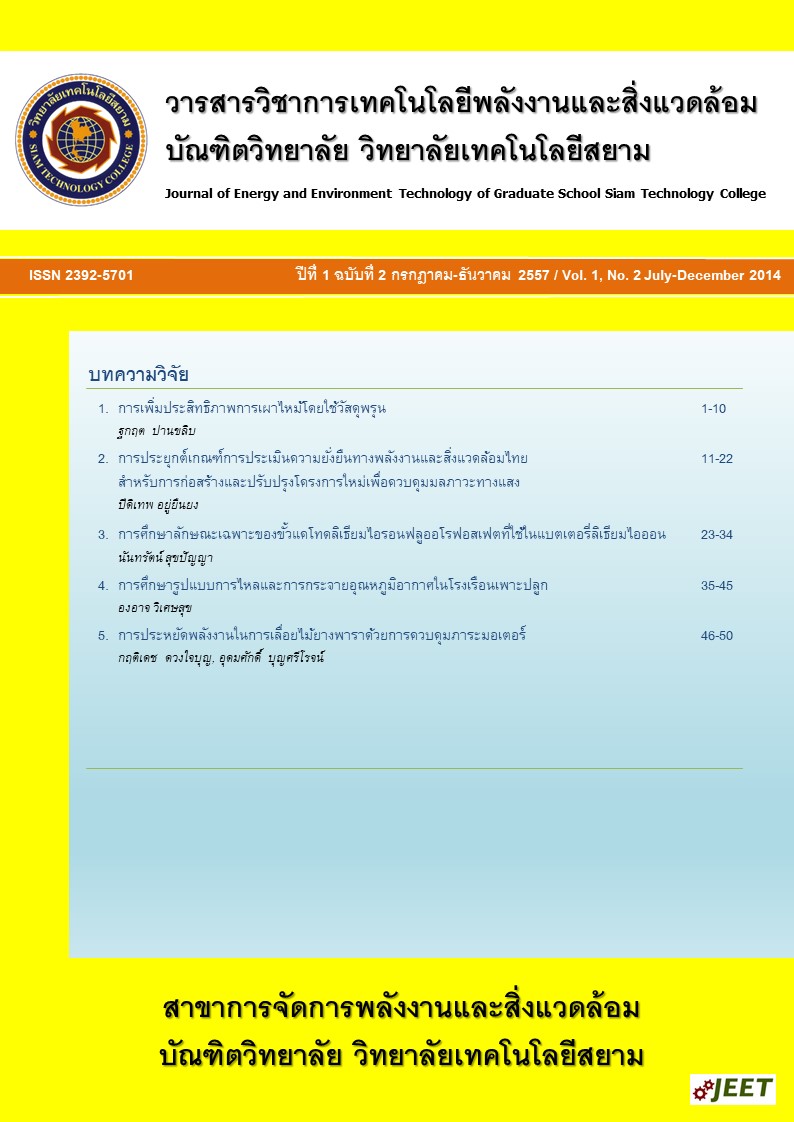Increasing the Combustion Efficiency by Using Porous Media
Main Article Content
Abstract
The total energy consumption in Thailand has been continually increasing. Most of the fuel used in Thailand is imported such as petroleum products. Although Thailand can provide some of its own energy resources such as natural gas crude oil and coal, the domestic energy resources are not sufficient because of the increasing demand and the limitation of these energy resources. So, utilization of remaining energy efficiency and researching new technologies for energy conservation becomes absolutely necessary. In the last few decades, many researchers have been studied in the field of multiphase combustion within porous media, due to its clean and highly efficient. The burning velocities are higher than normal combustion, extended lean flammability limits, and high radiant output with low emissions of pollutants such as NOx and CO. This paper reviews the physical properties and combustion processes within porous media, and describes related experimental and study. Including the unique of porous media such as heat re-circulating combustion, internal heat recirculation in porous burner, the burner performance and conclusions.
Article Details
เนื้อหาและข่อมูลในบทความที่ลงตีพิมพ์ในวารสารวิชาการ เทคโนโลยี พลังงาน และสิ่งแวดล้อม บัณฑิตวิทยาลัย วิทยาลัยเทคโนโลยีสยาม ถือเป็นข้อคิดเห็นและความรับผิดชอบของผู้เขียนบทความโดยตรง ซึ่งกองบรรณาธิการวารสารไม่จำเป็นต้องเห็นด้วย หรือว่าร่วมรับผิดชอบใด ๆ
บทความ ข้อมูล เนื้อหา รูปภาพ ฯลฯ ที่ได้รับการตีพิมพ์ในวารสารวิชาการ เทคโนโลยี พลังงาน และสิ่งแวดล้อม บัณฑิตวิทยาลัย วิทยาลัยเทคโนโลยีสยาม ถือเป็นลิขสิทธิ์ของวารสารวิชาการ เทคโนโลยี พลังงาน และสิ่งแวดล้อม บัณฑิตวิทยาลัย วิทยาลัยเทคโนโลยีสยาม หากบุคคล หรือหน่วยงานใดต้องการนำทั้งหมด หรือส่วนหนึ่งส่วนใดไปเผยแพร่ต่อ หรือเพื่อกระทำการใด ๆ จะต้องได้รับอนุญาต เป็นลายลักษณ์อักษรจากวารสารวิชาการ เทคโนโลยี พลังงาน และสิ่งแวดล้อม บัณฑิตวิทยาลัย วิทยาลัยเทคโนโลยีสยาม เท่านั้น
References
[2] Department of Alternative Energy Development and Efficiency. (2007). Thailand’s Energy Conservation and Renewable Energy Development Program 2008-2011, Bangkok: Ministry of Energy.
[3] Jugjai, S., et al, ‘Heat transfer Enhancement to Coolling Water Pipe by a Surface Combustor Heater Equipped with a Convection-Radiation Conveter’, RERIC International Energy Journal, Vol. 20, No. 2, pp 91-105, December, 1998.
[4] Weclas, M., Porous media in internal combustion engines, [in:] Cellular Ceramics Structure, Manufacturing, Properties and Applications, Scheffler, M., Colombo, P. (eds), Wiley-VCH-Publ.2005.
[5] Weclas, M., New strategies for homogeneous combustion in I.C. engines based on the porous medium (PM)-technology, ILASS Europe, June 2001.
[6] Afsharvahid, S., Dally, B.B. & Christo F.C. (2003). On the Stabilization of ultra-lean methane and propane flames in porous media. The 4th Asia-Pacific Conference on Combustion, Nanjing, Chaina, August 18-21.
[7] Trimis, D. & Durst, F. (1996). Combustion in a porous medium: Advance and applications. Combustion Science and Technology, 121, 153-168.
[8] C. Tierney and A.T. Harris. (2009). Journal of the Australian Ceramic Society Volume 45 [2], 2009, 20-29.
[9] Weinberg, F.J. (1971). Combustion temperature: the future?. Nature, 233, 239-241.
[10] Wongwatcharaphon, K. (2011). Numerical Simulation of High Efficiency Porous Burner for Liquid Fuel Combustion without Spray Atomization. D.Eng. Mechanical Engineering Faculty of Engineering, King Mongkut’s University of Technology Thonburi.
[11] Vafai, K. (2005). Handbook of porous media (2nded.). Taylor and Franscis, USA.
[12] Babkin, V.S., Korzhavin, A.A. & Buner, V.A. (1991). Propagation of premixed explosion flames in porous media. Combustion and Flame, 87, 182-190.
[13] Durst, F. & Trimis, D. (2002). Combustion by free flames versus combustion reactors. Clean Air, 3, 1–20.


